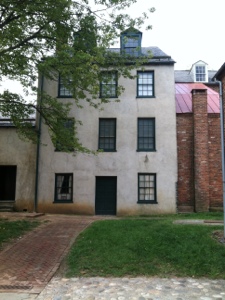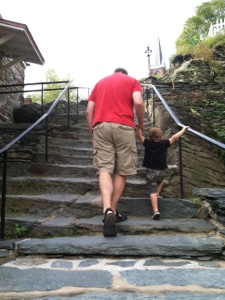I have a confession. I don’t wear underwear when I do Civil War living history.
No, instead of underwear, I wear period correct split leg drawers that come down to my knees. There was this deliciously bizarre moment this weekend when the guys were pulling up their trousers comparing socks and drawers and I was showing off the blue ribbon at the bottom of my drawers, which led to me asking, “Can I touch your sock?”
Yes.
 This weekend, the sesquicentennial rolled into Monocacy National Battlefield for their 150th Anniversary event. The decision had previously been made that we would “rough” it this weekend, meaning, instead of getting a hotel room, we were going to sleep on the battlefield. My initial response to this was “ehhhhhhh” followed by uncomfortable laughter. But, whatever, I’ll be a good sport and try it. Frederick, Maryland is practically within spitting distance, so in the event of frog sized spiders, rain, plagues, whatever, there’s always the means for escape.
This weekend, the sesquicentennial rolled into Monocacy National Battlefield for their 150th Anniversary event. The decision had previously been made that we would “rough” it this weekend, meaning, instead of getting a hotel room, we were going to sleep on the battlefield. My initial response to this was “ehhhhhhh” followed by uncomfortable laughter. But, whatever, I’ll be a good sport and try it. Frederick, Maryland is practically within spitting distance, so in the event of frog sized spiders, rain, plagues, whatever, there’s always the means for escape.
Just like the Gettysburg sesquicentennial event.
But, unlike the Gettysburg event, we didn’t have rain, park rangers showing up at midnight shining flashlights into car windows looking for medical emergencies, or heat/humidity to the point of sleeping in underwear and/or passing out in the middle of the demo. So, you can call that a success. No hotel rooms needed.
Upon arriving, once we were checked in with the park rangers and all official like, we were given gold medals. Which, frankly, is a great way to start any event. Welcome to Monocacy: here’s your medal. Sure, they were just our volunteer identification medals and mine spent the weekend jammed in between my boobs in my corset, but it’s awesome. I want to wear mine to work tomorrow.
The Hubs, a member of our group Kevin, and I promptly traversed what appeared to be a soybean field and checked out the position of the artillery pieces for the event. That’s what you do. We were delighted to see we had an entire battery–four guns–for the weekend. Yes! Section fire! Battery fire! Boys, black powder, and a sassy little Napoleon light gun howitzer. My three favorite things.
position of the artillery pieces for the event. That’s what you do. We were delighted to see we had an entire battery–four guns–for the weekend. Yes! Section fire! Battery fire! Boys, black powder, and a sassy little Napoleon light gun howitzer. My three favorite things.
As much as I love watching artillery demos and swooning over the boys who fire said artillery pieces, I am also an incredibly huge fan of just hanging out in camp, laughing and talking. This weekend we compiled a list of our top pickup lines. Of note:
- I’m going to rock you like a gravel road
- Step into the stairwell and I’ll show you where your kidneys are
- Can I palpate your liver?
- Well, if you need an ambulance one can be here in three minutes.
Three of these have happened to me (the last one happened this weekend and was not, I felt, an effective means of flirting). The top one is my favorite and one I kind of want to have made into a t-shirt. That’s not just a pickup line. That’s a life motto.
Interestingly enough, my forthcoming novel takes place in Frederick, Maryland and, up until this weekend, I’ve never actually been to Frederick, Maryland. I relied extensively on Google when writing my book. Anyway, so, after Saturday’s events I was kidnapped by three Confederates and one Union artillerymen and whisked away to Landon House. Landon House (which is currently under extensive renovation) features in possibly the longest chapter in my book and was site of the 1862 Jeb Stuart extravaganza, The Roses and Sabers Ball. Union artilleryman Jeff said, “You’re going to be disappointed because it’s being renovated. Just remember that. It’s under construction.”
 Maybe from the road looking down the lane and thinking, “I’d imagined it further away from the road” was me being disappointed, but up close the history nerd broke loose like some kind of scholarly Hulk-esq transformation and I squealed. Took a selfie. And I think I jumped up and down several times.
Maybe from the road looking down the lane and thinking, “I’d imagined it further away from the road” was me being disappointed, but up close the history nerd broke loose like some kind of scholarly Hulk-esq transformation and I squealed. Took a selfie. And I think I jumped up and down several times.
Rumor has it I also said things like, “Jeb Stuart was HERE! Omg.”
Weird doesn’t even begin to describe me, I know.
Also weird was our discovery of Babar murals and an extremely sad koi fish/overly happy frog murals in the exposed basement of Landon House. I’m not…I’m just not really sure why someone would paint a sad koi fish on the wall of anything. “The koi fish is sad because you don’t put away your toys.” Bizarre. And why is the koi fish so sad but the frogs are happy? If we’re consumed by Landon House, do the frogs disappear and the koi fish is suddenly happy? It’s another novel entirely, I suppose, but somehow we eventually segued from my Confederates trying to scandalize me with salacious talk, Union Jeff apologizing profusely, me able to hang on par with salacious talk, and then being accepted as one of their own. There was talk of camisoles, one-handed soldiers, roosters named Meatball. And then someone said, “We probably aren’t supposed to be up here.”
“We’ll just drive away really fast.”
“Yeah, because no one would ever be able to pick us out of a lineup. What were they wearing? Three Confederates, a Yankee, and a chick in a hoop skirt.”
chick in a hoop skirt.”
“Oh. Well. They’ll just think we belong up here then. I’m sure it’s fine.”
I’ll tell you what, it was an insanely fun time. It reminded me a lot of Gettysburg last year, with the laughter and eating dinner with my guys at the Trostle Farm. Doing living history for the frank love of history is awesome, but hanging out with friends like these are the best. We share a mutual love of history, shenanigans, and inappropriateness. We make obscure references and get really, overly excited about standing in historical places. We know more than you want to know about how artillery pieces are made and tactics and the historical applications of mercury and how prostatitis may or may not have affected AP Hill at Gettysburg. As my friend Luke said, “We’re all cut from the same cloth.” Not everyone wants to run around in the heat, humidity, ticks, and spiders the size of sparrows but we do. These are some of the coolest people I know.
I’m completely bummed out that our living history schedule of events is blank until October. We’ll possibly be at Cedar Creek, but definitely at Harpers Ferry. Halloween at the Heights! More on that to come.
 So, Monocacy was awesome. The battery fire was awesome. Running around with The Hubs and my artillery guys was awesome. My strangely shaped sunburn is not awesome and looks ridiculous with a tank top. My lips are chapped. But it was completely worth it.
So, Monocacy was awesome. The battery fire was awesome. Running around with The Hubs and my artillery guys was awesome. My strangely shaped sunburn is not awesome and looks ridiculous with a tank top. My lips are chapped. But it was completely worth it.
As confessions go, I don’t wear underwear when I reenact. I run around with artillerymen and Yankees and laugh at dirty jokes and have the mouth of a well-educated sailor. I may have been in a closed area this weekend looking at weird murals.
I wouldn’t trade it for the world.
(Special shout out to my guys: She just had really good muscle control and he had a wrist. You know, because of the war)

















